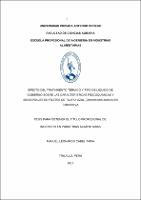Mostrar el registro sencillo del ítem
Efecto del tratamiento térmico y tipo de líquido de gobierno sobre las características fisicoquímicas y sensoriales en filetes de tilapia azul (oreochromis aureus) en conserva
| dc.contributor.advisor | Marquez Villacorta, Luis Francisco | |
| dc.contributor.author | Cabel Tapia, Manuel Leonardo | |
| dc.creator | Cabel Tapia, Manuel Leonardo | |
| dc.date.accessioned | 2019-09-30T20:57:54Z | |
| dc.date.available | 2019-09-30T20:57:54Z | |
| dc.date.issued | 2019 | |
| dc.identifier.uri | https://hdl.handle.net/20.500.12759/5490 | |
| dc.description.abstract | Se evaluó el efecto del tratamiento térmico y tipo de líquido de gobierno sobre el color, firmeza, apariencia y aceptabilidad general en una conserva de filetes de tilapia. Se consideraron tres tratamientos térmicos (113 °C x 66.65 min, 115 °C x 47.59 min, 117 °C x 35.69 min) a un mismo valor de muerte térmica de F 0= 8 min para asegurar la esterilidad comercial, así como, dos tipos de líquido de gobierno: salsa escabechada y salsa de tomate. El color y la firmeza se evaluaron mediante colorímetro Konica Minolta y texturómetro Instron, respectivamente. El análisis de varianza mostró que la variable tipo de líquido de gobierno presentó efecto significativo (p<0.05) sobre las características de color L* y a*, más no sobre el parámetro b* y la firmeza, mientras la variable tratamiento térmico presentó efecto significativo (p<0.05) sólo sobre la firmeza. La prueba de Duncan indicó que el tratamiento térmico de 117 °C x 35.69 min y salsa tipo escabechada presentó el mayor valor de L* (55.14), siendo considerado como el mejor tratamiento para esta variable, al generar una menor degradación del color y mayor valoración visual, mientras para cromaticidad a* el tratamiento térmico de 115 °C x 35.69 min y salsa de tomate presentó el mayor valor de a* (9.08), siendo considerado como el mejor tratamiento, así mismo, indicó que la muestra obtenida con salsa tipo escabechada y tratamiento térmico de 117 °C x 35.69 min, presentó el valor más alto de firmeza (1.97 N), siendo el mejor tratamiento. Para las variables no paramétricas se utilizó la prueba de Friedman, en la evaluación de la apariencia y aceptabilidad general se utilizó una escala hedónica de 9 puntos, encontrándose la existencia de diferencias significativas (p<0.05). Se demostró para ambas características que la muestra obtenida con salsa tipo escabechada y tratamiento térmico de 117 °C x 35.69 min, fue la mejor al obtener la calificación más alta de aceptabilidad y apariencia general con 6.50 puntos y 6.17 puntos respectivamente, ambos correspondientes a una percepción “Me gusta ligeramente”, siendo considerado como el mejor tratamiento en esta investigación. | es_PE |
| dc.description.abstract | The effect of the thermal treatment and type of covering liquid on the color, firmness, appearance and general acceptability in a tilapia fillet preserves was evaluated. Three thermal treatments (113 ° C x 66.65 min, 115 ° C x 47.59 min, 117 ° C x 35.69 min) were considered at the same thermal death value of F 0 = 8 min to ensure commercial sterility, as well as, two types of covering liquid: pickled sauce and tomato sauce. Color and firmness were evaluated using the Konica Minolta colorimeter and Instron texturometer, respectively. The analysis of variance showed that the variable type of covering liquid had a significant effect (p <0.05) on the color characteristics L * and a*, but not on the parameter b* and firmness, while the thermal treatment variable had a significant effect (p <0.05) only on firmness. The Duncan test indicated that the thermal treatment of 117 ° C x 35.69 min and pickled sauce had the highest value of L* (55.14), being considered as the best treatment for this variable, by generating a lower color degradation and greater visual value, whereas for chromaticity *a thermal treatment of 115 °C x 35.69 min and tomato sauce presented the highest value (9.08), being considered as the best treatment, which likewise indicated that the sample obtained with pickled type sauce and thermal treatment of 117 °C x 35.69 min, presented the highest value of firmness (1.97 N), being the best treatment for this variable. Friedman's test was used for the non-parametric variables where a 9-point hedonic scale was used in the evaluation of the overall appearance and acceptability. Significant differences (p <0.05) were found. It was demonstrated for both characteristics that the sample obtained with pickled type sauce and thermal treatment of 117 °C x 35.69 min, was the best having obtained the highest qualification of acceptability and general appearance with 6.50 points and 6.17 points respectively, both corresponding to a perception ““I like it lightly““, resulting in being considered as the best treatmentin this research. | en_US |
| dc.description.uri | Tesis | es_PE |
| dc.format | application/pdf | es_PE |
| dc.language.iso | spa | es_PE |
| dc.publisher | Universidad Privada Antenor Orrego | es_PE |
| dc.relation.ispartofseries | T_ALIM_328 | |
| dc.rights | info:eu-repo/semantics/openAccess | es_PE |
| dc.rights.uri | https://creativecommons.org/licenses/by/4.0/ | es_PE |
| dc.source | Universidad Privada Antenor Orrego | es_PE |
| dc.source | Repositorio Institucional - UPAO | es_PE |
| dc.subject | Térmico | es_PE |
| dc.subject | Tilapia | es_PE |
| dc.title | Efecto del tratamiento térmico y tipo de líquido de gobierno sobre las características fisicoquímicas y sensoriales en filetes de tilapia azul (oreochromis aureus) en conserva | es_PE |
| dc.type | info:eu-repo/semantics/bachelorThesis | es_PE |
| thesis.degree.level | Título Profesional | es_PE |
| thesis.degree.grantor | Universidad Privada Antenor Orrego. Facultad de Ciencias Agrarias | es_PE |
| thesis.degree.name | Ingeniero en Industrias Alimentarias | es_PE |
| thesis.degree.discipline | Ingeniería en Industrias Alimentarias | es_PE |
| dc.publisher.country | PE | es_PE |
Ficheros en el ítem
Este ítem aparece en la(s) siguiente(s) colección(es)
-
Industrias Alimentarias [152]


